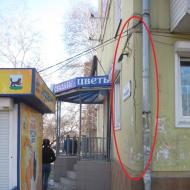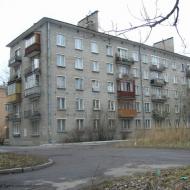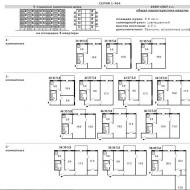
What does an increase in the refinancing rate mean? Refinancing of the Central Bank. Refinancing rate for an accountant
The refinancing rate of the Central Bank of the Russian Federation is the percentage at which the Central Bank gives loans to commercial banks. Also, the rate is mentioned in laws for the purpose of calculating interest and penalties for failure to fulfill various monetary obligations.
The refinancing rate of the Central Bank of the Russian Federation for today
On December 13, 2019, at a meeting of the Board of Directors of the Bank of Russia, it was decided to reduce the value of the key rate.
Refinancing rate (aka key rate) The Central Bank of the Russian Federation for today (01/30/2020) is 6.25% per annum. The rate is valid from December 16, 2019 to February 7, 2020. The validity period was established by the Central Bank of the Russian Federation.
Refinancing rate of the Central Bank of the Russian Federation in 2019: table
| Meeting date | Meaning | Start date of the new bet |
|---|---|---|
| 12/13/2019 | 6.25 (current level) | 12/16/2019 |
| 10/25/2019 | 6,50 | 10/28/2019 |
| 09/06/2019 | 7,00 | 09.09.2019 year |
| 07/26/2019 | 7,25 | 07/29/2019 |
| 06/14/2019 | 7,50 | 06/17/2019 |
| 12/14/2018 | 7,75 | 12/17/2018 |
| 09/14/2018 | 7,50 | September 17, 2018 |
| 03/23/2018 | 7,25 | 03/26/2018 |
| 02/09/2018 | 7,50 | 02/12/2018 |
| 12/15/2017 | 7,75 | 12/18/2017 |
| 10/27/2017 | 8,25 | 10/30/2017 |
| 09/15/2017 | 8,50 | September 18, 2017 |
| June 16, 2017 | 9,00 | June 19, 2017 |
| 04/28/2017 | 9,25 | 05/02/2017 |
| 03.24.2017 year | 9,75 | 03/27/2017 |
| September 16, 2016 | 10,00 | 09/19/2016 |
| June 10, 2016 | 10,50 | June 14, 2016 |
| 07/31/2015 | 11,00 | 08/03/2015 |
| June 15, 2015 | 11,50 | June 16, 2015 |
| 04/30/2015 | 12,50 | 05.05.2015 year |
| 03/13/2015 | 14,00 | 03/16/2015 |
| 01/30/2015 | 15,00 | 02.02.2015 |
| 12/16/2014 | 17,00 | 12/16/2014 |
| 12/11/2014 | 10,50 | 12.12.2014 |
| 11/05/2014 | 9,50 | 11/05/2014 |
| 07/25/2014 | 8,00 | 07/28/2014 |
| 04/25/2014 | 7,50 | 04/28/2014 |
| 03.03.2014 | 7,00 | 03.03.2014 |
| 09/13/2013 | 5,50 | 09/13/2013 |
The new key rate value takes effect from the next business day. All scheduled meetings are held on Friday, and accordingly new rate begins to operate from the next Monday. Provided that it does not fall on a state day off.
Meeting of the Central Bank of the Russian Federation on the key rate - schedule for 2020
The next meeting of the Bank of Russia Board of Directors, which will consider the issue of the key rate, is scheduled for February 7, 2020. The time of publication of the press release on the decision of the Board of Directors of the Bank of Russia and the mid-term forecast is 13:30 Moscow time
The revision of the key rate is entrusted to the Board of Directors of the Central Bank of the Russian Federation. The dates of its scheduled meetings are determined in advance - the schedule for 2020 was formed in the third quarter of 2019. The dates are set as follows:
- 02/07/2020 (next meeting);
- 03/20/2020;
- 04/24/2020;
- 06/19/2020;
- 07/31/2020;
- 09/18/2020;
- 10/30/2020;
- 12/18/2020
As in previous years, in 2020, according to the schedule, eight meetings of the Board of Directors of the Central Bank of the Russian Federation are planned on the issue of revising the key rate of the regulator. Here it can be noted that unscheduled meetings can also be held. True, this is a rare occurrence. For example, such a case occurred at the end of 2014, when an urgent response to global changes in Russia was required. There are no prerequisites for such a situation in 2020, at least for now.
Refinancing rate of the Central Bank of the Russian Federation for 2020
The Bank of Russia makes decisions on monetary policy primarily on the basis of a medium-term macroeconomic forecast, which is calculated for three years in advance. When preparing a forecast, the Bank of Russia considers significant external and internal factors in the development of the Russian economy and inflation dynamics, including the announced measures of macroeconomic policy. It is within the framework of the forecast that the trajectory of the key rate is determined, which is necessary to maintain inflation close to 4% in the medium term.
In forming its forecast for the next three years, the Bank of Russia believes that the set and nature of the action of fundamental factors influencing the situation in Russian economy and price dynamics will not change significantly.
To fix inflation near 4%, it is important to create conditions for stabilizing inflation expectations at a low level, reducing their sensitivity to the influence of temporary factors, and ensuring confidence in the ongoing monetary policy. This will require maintaining a careful, balanced approach to changing the key rate while gradually realizing the potential for its reduction, as well as clear and consistent communication. Only as confidence in the policy pursued by the Bank of Russia is built up will it be possible to speak of a long-term sustainable result in ensuring price stability.
What is the refinancing rate of the Central Bank of the Russian Federation
In Russia, the refinancing rate was introduced on January 1, 1992. According to telegram dated December 29, 1991 No. 216-91 central bank Russia has introduced a flat rate for the provision of loans to commercial banks. The purpose of introducing a single rate was to stabilize money circulation in Russia, as well as to stimulate a market economy.
Subsequently, this rate was used for other purposes. The Tax Code provides for cases when the refinancing rate is used, including:
- penalties for late payment of taxes, fees, contributions are calculated based on the amount of delay and a share (1/300) of the refinancing rate for each day from the deadline payment before the date of actual payment;
- material benefit(savings on interest on loans) is also calculated based on the loan amount and a share (2/3) of the refinancing rate.
How much interest for each day of delay for today (2019):
- penalty interest 1/300 of the refinancing rate (key rate) of the Central Bank of the Russian Federation is 0.0208%
- penalty interest 1/150 of the refinancing rate (key rate) of the Central Bank of the Russian Federation is 0.0417%
- penalty interest 1/130 of the refinancing rate (key rate) of the Central Bank of the Russian Federation is 0.0481%
To get the amount per day, you need to multiply the amount by the above percentage and divide by 100.
In relations with counterparties, the Civil Code also implies the use of a refinancing rate. So, for example, Art. 809 of the Civil Code of the Russian Federation allows you to collect interest from the borrower based on the bank rate, if the terms of interest are not spelled out in the agreement. And reciprocal sanctions for violation of contractual obligations (fines, penalties for late payments, late delivery dates, etc.) are often linked to the refinancing rate in contracts.
How the key rate and bank refinancing rate are related
At the end of 2015, the Central Bank, based on the decision of the Board of Directors of the Bank of Russia, issued Instruction No. 3894-U dated December 11, 2015, which equated the value of the refinancing rate to the key rate. The directive entered into force on January 1, 2016. Since then, the independent value of the refinancing rate has never been established.
The key rate appeared in Russia in 2013, when the information of the Bank of Russia dated 09/13/2013 “On the system of interest rate instruments of the monetary policy of the Bank of Russia” was published. Now, not a fixed rate is used for lending to commercial banks, but a corridor of interest rates. The key rate denotes the minimum amount of interest at which loans are credited commercial banks for a week. And also this maximum percentage, under which deposits of commercial banks are placed for the same period.
At the same time, the refinancing rate has not been abolished. Only its role in the system of instruments of the Central Bank has changed. And as before, the calculation methods used in some articles of the tax and civil codes are tied to the refinancing rate.
Reduced refinancing rate
Several years ago, the Russian government set itself the goal of bringing inflation down to 4%. Until today, this has not been achieved, but positive dynamics in this direction is still observed. Thanks to the positive changes, the Central Bank again lowered its key rate (and hence the refinancing rate). The specialists predict the continuation of the key rate cut.
The Central Bank of the Russian Federation raised the refinancing rate. Today it has increased by 0.25 points. You will find a table of its values used earlier, a table of rates of the Bank of Russia for all operations, as well as a forecast of changes in this article.
The RF Central Bank set the refinancing rate for the first time in 1992. Initially, it was introduced to realize the opportunity to stimulate the market economy and money circulation on the territory of the Russian Federation. But then they began to use it for other purposes. So, according to Tax Code it is needed to calculate:
- penalties for violation of the deadlines for the payment of taxes, fees and contributions (the calculation is based on the unpaid amount and 1/300 of the refinancing rate for each day of delay before the date of actual payment);
- material benefits or savings on interest on loans (the calculation is based on the loan amount and 2/3 of the refinancing rate).
Our free online service will allow you to prepare payment order for the timely payment of taxes, fees and insurance premiums:
Make a payment
According to the Civil Code, using the rate, you can determine:
- the amount of interest due from the borrower based on the bank rate, if the conditions for interest were not spelled out in the agreement;
- fines and penalties for late payments, violation of delivery dates, etc.
Refinancing rate now and in the future
The refinancing rate is now 7.50% per annum. Since September 17, 2018, the Central Bank of the Russian Federation has increased it by 0.25 points.
The next meeting of the Board of Directors on the level of the refinancing rate will be held on October 26, 2018.
Specialists of the Central Bank of the Russian Federation note that the return of the annual inflation rate to 4% is going faster than the forecast. In August 2018, the annual growth rate consumer prices came out to 3.1%. Inflation is growing due to an increase to 1.9% of the annual rate of increase in prices for food product groups.
According to forecasts, the growth rate of consumer prices will reach the level of 3.8-4.2% by the end of 2018. The annual inflation rate will peak in the first half of 2019. By the end of 2019, it will be 5.0-5.5%. The quarterly growth rate of consumer prices in annual terms will slow down to 4% in the II half of 2019. In the first half of 2020, annual inflation will return to 4%. During this period, the effects of the depreciation of the ruble and the increase in VAT will be exhausted.
Thus, the Central Bank of the Russian Federation will assess the possibility of a further increase in the refinancing rate, taking into account the dynamics of inflation and the economy in accordance with the above forecast. The risks from external conditions and the response to them of financial markets will also be taken into account.
Refinancing rate in 2018 and earlier (table)
Over the entire history of its existence, the value of the refinancing rate of the Central Bank of the Russian Federation has changed quite often and in different ranges. So, the first percentage was 20%. Five months later, it quadrupled and continued to grow rapidly until mid-1994. Having reached a peak, it hovered around 200% for several years. In the early 2000s, the rate was reduced to an acceptable level.
Table. All values of the refinancing rate of the Central Bank of the Russian Federation and the key rate
| Application start date | Refinancing rate value (key rate),% per annum | Bank of Russia document |
| 17 september 2018 | 7,50 |
Information: |
| 26 March 2018 | 7,25 | |
| 12 february 2018 | 7,50 | from 09.02.2018 |
| December 18, 2017 | 7,75 | dated 15.12.2017 |
| 30 october 2017 | 8,25 | dated 10/27/2017 |
| September 18, 2017 | 8,50 | from 15.09.2017 |
| 19 June 2017 | 9,00 | |
| 2 May 2017 | 9,25 | |
| March 27, 2017 | 9,75 | |
| September 19, 2016 | 10,00 | |
| 14 June 2016 | 10,50 | |
| 01 January 2016 | 11,00 | |
| August 3, 2015 | 11 |
dated 11.12.2015 from 30.10.2015 from 11.09.2015 dated July 31, 2015 |
| June 16, 2015 | 11,5 |
from 15.06.2015 |
| May 5, 2015 | 12,5 |
dated April 30, 2015 |
| March 16, 2015 | 14 |
dated 03/13/2015 |
| 02 February 2015 | 15 |
from 30.01.2015 |
| December 16, 2014 | 17 |
dated 16.12.2014 |
| 12 December 2014 | 10,5 |
dated 11.12.2014 |
| November 5, 2014 | 9,5 |
from 31.10.2014 |
| 28 July 2014 | 8 |
from 25.07.2014 |
| 28 April 2014 | 7,5 |
from 25.04.2014 |
| 03 March 2014 | 7 |
from 03.03.2014 |
| 13 September 2013 | 5,5 |
from 13.09.2013 |
| 14 September 2012 | 8,25 |
Indication: dated 13.09.2012 No. 2873-U |
| December 26, 2011 | 8 |
dated 23.12.2011 No. 2758-U |
| May 3, 2011 | 8,25 |
dated 29.04.2011 No. 2618-U |
| 28 February 2011 | 8 |
dated 25.02.2011 No. 2583-U |
| June 1, 2010 | 7,75 |
dated May 31, 2010 No. 2450-U |
| April 30, 2010 | 8 |
dated April 29, 2010 No. 2439-U |
| March 29, 2010 | 8,25 |
dated 26.03.2010 No. 2415-U |
| February 24, 2010 | 8,5 |
dated 19.02.2010 No. 2399-U |
| December 28, 2009 | 8,75 |
dated 25.12.2009 No. 2369-U |
| November 25, 2009 | 9 |
dated 24.11.2009, No. 2336-U |
| October 30, 2009 | 9,5 |
dated October 29, 2009 No. 2313-U |
| September 30, 2009 | 10 |
dated 29.09.2009 No. 2299-U |
| September 15, 2009 | 10,5 |
dated September 14, 2009 No. 2287-U |
| August 10, 2009 | 10,75 |
dated 7.08.2009, No. 2270-U |
| 13 July 2009 | 11 |
dated 10.07.2009 No. 2259-U |
| June 5, 2009 | 11,5 |
dated 4.06.2009, No. 2247-U |
| May 14, 2009 | 12 |
dated May 13, 2009 No. 2230-U |
| April 24, 2009 | 12,5 |
dated 23.04.2009 No. 2222-U |
| December 1, 2008 | 13 |
dated 28.11.2008 No. 2135-U |
| 12 November 2008 | 12 |
dated 11.11.2008 No. 2123-U |
| July 14, 2008 | 11 |
dated July 11, 2008 No. 2037-U |
| June 10, 2008 | 10,75 |
dated June 9, 2008 No. 2022-U |
| April 29, 2008 | 10,5 |
dated 28.04.2008 No. 1997-U |
| February 4, 2008 | 10,25 |
dated 1.02.2008 No. 1975-U |
| June 19, 2007 | 10 |
dated 18.06.2007 No. 1839-U |
| January 29, 2007 | 10,5 |
dated 26.01.2007 No. 1788-U |
| October 23, 2006 | 11 |
dated 20.10.2006 No. 1734-U |
| June 26, 2006 | 11,5 |
Telegram: dated 23.06.2006 No. 1696-U |
| December 26, 2005 | 12 |
dated 23.12.2005, No. 1643-U |
| June 15, 2004 | 13 |
dated 11.06.2004 No. 1443-U |
| January 15, 2004 | 14 |
dated 14.01.2004, No. 1372-U |
| June 21, 2003 | 16 |
dated 20.06.2003 No. 1296-U |
| 17 February 2003 | 18 |
dated 14.02.2003 No. 1250-U |
| August 7, 2002 | 21 |
dated 6.08.2002 No. 1185-U |
| April 9, 2002 | 23 |
dated 8.04.2002 No. 1133-U |
| November 4, 2000 | 25 |
dated 3.11.2000 No. 855-U |
| 10 July 2000 | 28 |
dated 07.07.2000 No. 818-U |
| March 21, 2000 | 33 |
from 20.03.2000, No. 757-U |
| 7 March 2000 | 38 |
dated 6.03.2000, No. 753-U |
| January 24, 2000 | 45 |
dated January 21, 2000 No. 734-U |
| June 10, 1999 | 55 |
dated 9.06.1999 No. 574-U |
| July 24, 1998 | 60 |
dated 24.07.1998, No. 298-U |
| June 29, 1998 | 80 |
dated 26.06.1998, No. 268-U |
| June 5, 1998 | 60 |
dated 4.06.1998, No. 252-U |
| May 27, 1998 | 150 |
dated May 27, 1998 No. 241-U |
| May 19, 1998 | 50 |
dated 18.05.1998, No. 234-U |
| March 16, 1998 | 30 |
dated 13.03.1998 No. 185-U |
| March 2, 1998 | 36 |
dated 27.02.1998, No. 181-U |
| 17 February 1998 | 39 |
dated 16.02.1998 No. 170-U |
| February 2, 1998 | 42 |
dated 30.01.1998, No. 154-U |
| November 11, 1997 | 28 |
dated 10.11.1997 No. 13-U |
| October 6, 1997 | 21 |
dated 1.10.1997, No. 83-97 |
| June 16, 1997 | 24 |
dated 13.06.1997, No. 55-97 |
| April 28, 1997 | 36 |
dated 04.24.1997, No. 38-97 |
| February 10, 1997 | 42 |
dated 7.02.1997, No. 9-97 |
| December 2, 1996 | 48 |
dated 29.11.1996, No. 142-96 |
| October 21, 1996 | 60 |
dated 18.10.1996, No. 129-96 |
| August 19, 1996 | 80 |
dated 16.08.1996, No. 109-96 |
| July 24, 1996 | 110 |
from 23.07.1996, No. 107-96 |
| February 10, 1996 | 120 |
dated 9.02.1996, No. 18-96 |
| December 1, 1995 | 160 |
dated 29.11.1995, No. 131-95 |
| October 24, 1995 | 170 |
dated 23.10.1995, No. 111-95 |
| June 19, 1995 | 180 |
dated 16.06.1995, No. 75-95 |
| May 16, 1995 | 195 |
dated 15.05.1995, No. 64-95 |
| January 6, 1995 | 200 |
dated 5.01.1995, No. 3-95 |
| November 17, 1994 | 180 |
dated 16.11.1994, No. 199-94 |
| October 12, 1994 | 170 |
dated 11.10.1994, No. 192-94 |
| August 23, 1994 | 130 |
dated 22.08.1994, No. 165-94 |
| August 1, 1994 | 150 |
dated July 29, 1994, No. 156-94 |
| June 30, 1994 | 155 |
dated June 29, 1994, No. 144-94 |
| June 22, 1994 | 170 |
dated 21.06.1994, No. 137-94 |
| June 2, 1994 | 185 |
dated 1.06.1994, No. 128-94 |
| May 17, 1994 | 200 |
dated 16.05.1994, No. 121-94 |
| April 29, 1994 | 205 |
dated 28.04.1994, No. 115-94 |
| October 15, 1993 | 210 |
dated 14.10.1993, No. 213-93 |
| September 23, 1993 | 180 |
dated 22.09.1993, No. 200-93 |
| July 15, 1993 | 170 |
dated 14.07.1993 No. 123-93 |
| June 29, 1993 | 140 |
from 28.06.1993, No. 111-93 |
| June 22, 1993 | 120 |
dated 06.21.1993, No. 106-93 |
| June 2, 1993 | 110 |
dated 1.06.1993, No. 91-93 |
| March 30, 1993 | 100 |
dated 29.03.1993, No. 52-93 |
| May 23, 1992 | 80 |
dated May 22, 1992 No. 01-156 |
| April 10, 1992 | 50 |
dated 10.04.1992, No. 84-92 |
| January 1, 1992 | 20 |
dated 29.12.1991, No. 216-91 |
Table from the official website of the Central Bank of the Russian Federation of rates for all operations

Relationship between the key rate and the refinancing rate
The key rate is the minimum interest rate for lending to a commercial bank for a seven-day period. It is also the maximum percentage of placing a deposit of a commercial bank for 7 days.
The key rate has been in effect since 2013. But since January 1, 2016, the Central Bank of the Russian Federation has equated its value to the refinancing rate (Instruction No. 3894-U dated December 11, 2015). Now the Central Bank of the Russian Federation changes the key rate, and the refinancing rate is adjusted accordingly.
The interest rate corridor is now used for lending to commercial banks.
The role of the refinancing rate in the system of instruments of the Central Bank of the Russian Federation has also changed. But the methods for calculating the indicators established by the Tax and Civil Codes are still tied to it.
Refinancing rate for an accountant
It is important for an accountant to know the refinancing rate in order to calculate:
- the amount of interest for late taxes or insurance premiums;
- the amount of income of an individual in the form of material benefits on loans;
- interest returned later term of personal income tax;
- compensation for delayed wages.
Late payment interest. If you decide to submit a revised declaration or a revised calculation of contributions, first pay additional unpaid tax or contributions, as well as late fees (subparagraph 1, clause 4 of article 81 of the Tax Code). If your delay with taxes or contributions is no more than 30 days, calculate the amount of the penalty using the formula:
Penalty = Cn * Cd * 1/300 * Wed,
If the delay is 31 days or more, use a different formula:
Penalty = Cn * 30 * 1/300 * Wed + Cn * Cd * 1/150 * Wed,
where penalties are penalties for late tax or insurance premiums,
SN - the amount of late paid tax or contributions,
Kd - the number of days of delay,
Wed - the refinancing rate of the Central Bank of the Russian Federation, in effect in the period of delay.
Personal income tax with material benefits on loans. If your organization issued a loan to an employee or other related person in rubles without interest or at a low interest rate, this employee receives income in the form of material benefits. You must calculate personal income tax from this income on the last day of each month (subparagraph 1 of paragraph 1 of article 212 and subparagraph 7 of paragraph 1 of article 223 of the Tax Code). Personal income tax rate from income in the form of material benefits - 35%. To calculate the tax, use the formula (sub-clause 2, clause 2 of article 212 and clause 2 of article 224 of the Tax Code):
Personal income tax = Cs * (2/3 * Cp - C) / D * Cd * 35%,
where personal income tax - personal income tax with material benefits from savings on interest,
Сз - the amount of the loan,
Wed - the refinancing rate in effect on the last day of the month,
С - loan rate,
D - 365 (366) days,
Кд - the number of calendar days of using the loan in a month.
Please note that if you issued a loan to an individual who is not interdependent, the material benefit is not subject to personal income tax (clause 1 of article 212 of the Tax Code).
Interest for personal income tax returned after the deadline. If you withheld extra personal income tax from the employee by mistake and did not return the tax on time, you must pay interest to this employee. We remind you that you are obliged to inform the employee about each case of unduly withheld personal income tax. The employee writes an application for a return (clause 1 of article 231 of the Tax Code). And you, as an employer, are obliged to return the amount within three months after the application Personal income tax for an employee... For delays, interest is paid based on the refinancing rate (paragraph 5, clause 1 of article 231 of the Tax Code). The formula is as follows:
Cn = Su * Cp,
where Cp is the amount of interest due to the employee for personal income tax returned later than the deadline, Su is the amount of excessively withheld personal income tax that was not returned on time, Cp is the refinancing rate in effect for the period from the day when personal income tax should have been returned to the day of actual payment.
Compensation for delayed wages. You are required to pay your salary on time at least every fortnight. For the delay, employees are entitled to compensation (Article 236 of the Labor Code of the Russian Federation). Minimum amount compensation is calculated according to the formula: Ck = Cs * Cd * 1/150 * Cp, where Cc is the amount of compensation due to the employee for delayed wages, Cs is the amount of salary that was paid late, Cd is the number of days late, Wed is the refinancing rate of the Central Bank RF, valid during the period of delay.
The law sets only the minimum compensation. If your organization has adopted a higher amount of compensation, you are obliged to pay the amount according to internal documents.
Pursuant to Article 3 of the Federal Law "On the Central Bank Russian Federation(Bank of Russia) and in accordance with Articles 4, 35, 36, 37, 40, 43, 46 and 47 of the said Federal Law, the Bank of Russia, being the lender of last resort, organizes a system of refinancing (lending) of credit institutions, including establishing the procedure and refinancing conditions, and also carries out refinancing operations of credit institutions, thereby ensuring liquidity regulation banking system and provided for in Article 28 of the Federal Law "On Banks and banking»The right of credit institutions in the event of a lack of funds for lending to customers and fulfilling their obligations to apply for loans to the Bank of Russia on terms determined by it. Lending operations are carried out within the framework of agreements concluded between the Bank of Russia and credit institutions in accordance with Chapters 23, 28, 42, 45 (Article 850) Civil Code Of the Russian Federation, as well as Federal law"On banks and banking activities". The procedure for carrying out refinancing operations is presented in two regulatory documents Bank of Russia: in the Regulation of the Bank of Russia dated August 4, 2003 No. 236-P “On the procedure for the provision by the Bank of Russia credit institutions loans secured by collateral (blocking) valuable papers", And Regulation of the Bank of Russia No. 312-P" On the procedure for the provision of loans by the Bank of Russia to credit institutions secured by assets or guarantees ".
Refinancing by the Central Bank of commercial banks is understood as providing them with loans when banks have exhausted their resources or are unable to replenish them from other sources. The refinancing process consists in restoring the portfolio of commercial banks' own resources and funds invested in the circulation of capital of enterprises.
Refinancing loans are issued, as a rule, only to stable banks experiencing temporary financial difficulties... Refinancing loans are classified depending on:
- - forms of security (accounting and pawn loans);
- - presentation methods (direct loans and loans provided through auctions);
- - terms of provision (medium-term - for 3-4 months and short-term - for 1 or several days);
- - targeted (adjustment loans and extended seasonal loans).
Refinancing mechanisms serve as a last resort for commercial banks to regulate their liquidity. Banks are forced to turn to refinancing when opportunities to increase liquidity in the interbank and open markets have been exhausted, and then the Central Bank becomes the lender of last resort.
The practice of Central Banks foreign countries it was established that an effective mechanism for regulating banks' liquidity can be only when setting penal interest rates on refinancing loans and deposits: the lowest when depositing funds (corresponding to the very low level interest on money market deposits) and the highest for lending to banks (corresponding to the maximum level in relation to money market rates). This allows the central bank to avoid the role of broker in the interbank market.
Secured loans of the Bank of Russia can be divided into 2 groups depending on the collateral used:
- loans secured by marketable assets
- loans secured by non-marketable assets (promissory notes of organizations of the real sector of the economy or rights of claim under credit agreements with the specified organizations) or guarantees of credit institutions.
Volumes of lending operations by the Bank of Russia (in million rubles)
|
Month year |
Volume of provided intraday loans |
Overnight loans provided |
Volume of Lombard Loans Provided |
Volume of other loans provided |
|
TOTAL FOR 2004 |
||||
|
TOTAL 2005 |
||||
|
TOTAL FOR 2006 |
||||
|
TOTAL FOR 2007 |
||||
|
TOTAL FOR 2008 |
||||
|
TOTAL FOR 2009 |
||||
|
September |
||||
|
Total for 2010 |
The refinancing rate plays an important role among the interest rates of the Bank of Russia. Variable depending on the economic situation, the refinancing rate performs signaling functions, providing money market participants with information on the Bank of Russia assessment of the current inflation rate and prospects for its development, and thereby influencing the inflation expectations of economic entities. However, the task of this rate is not to promptly influence the change current situation on the interbank market.
The refinancing rate of the Central Bank of the Russian Federation is the interest rate that the Central Bank of the Russian Federation uses when granting loans to commercial banks in the refinancing procedure.
The refinancing rate is the market-driven rate for some of the most active operations The Central Bank, and is used to interact with commercial banks. Today the refinancing rate is a kind of "contractual" mechanism for identifying the average cost of money and is used primarily for fiscal purposes. In fact, the refinancing rate is not an instrument that reflects the market nature of transactions. And it is only needed to understand the value of money, since in market economy you can't do without it. The value of the refinancing rate can be established by competitive selection, or it can be simply appointed.
The refinancing rate is also a "kind" accompanying mechanism to curb inflationary processes in Russia. With a decrease in the rate of inflation, the refinancing rate also decreases.
Based on the foregoing, it can be stated that the Central Bank of Russia rate is a tool with which the Bank of Russia influences interest rates on deposits and loans provided by credit institutions to legal and individuals... Therefore, in their interest rate policy, commercial banks are largely guided by the rate of the Central Bank of Russia.
Do changes in the refinancing rate affect the financial situation of the population? Yes, they do! In a situation where the Central Bank's rate goes down, on the one hand, borrowers will benefit, and on the other hand, depositors of Russian banks lose, losing part of the profit from their investments. Each change in the refinancing rate is a messenger of the fact that in the near future, changes (revisions) by commercial banks in interest rates on deposits and loans are possible. An analysis of the formation of interest rates on deposits of most of the leading commercial banks in Russia confirms this. The refinancing rate always reaches almost the level of inflation, which means that in addition to reducing profits, interest on most deposits turns out to be below the inflation rate and deposits are gradually depreciating.
Rates on overnight and intraday loans are used by the Bank of Russia when granting loans to banks to secure payments on correspondent accounts during the day and to complete the business day. The volumes of such loans in the presence of free liquidity are small, and therefore these interest rates do not have a decisive influence on the change in the situation with liquidity in the interbank credit market. The rate on pawnshop auctions at the current level of banks' liquidity also does not significantly affect the rates of the interbank credit market. In these conditions, the most significant role is played by the rates on deposit operations of the Bank of Russia and operations with bonds of the Bank of Russia with banks.
What is it - the Central Bank rate, what is it for? We often hear about this indicator, but not everyone understands its meaning. The article understandable language explains the value of the refinancing percentage of the Central Bank of the Russian Federation.
If it's quite simple
The refinancing rate of the Central Bank of the Russian Federation is the interest at which commercial banks and financial institutions borrow money from the country's Central Bank. The central bank acts as the creditor of the entire banking system. The indicator is calculated as an annual percentage.
On simple example the borrowing process looks like this:
Commercial Bank receives from the Central Bank 100,000,000 rubles at 10.5% per annum. In a year, he must return the amount of debt and interest in the amount of 10,500,000 rubles. Only 110,500,000 rubles.
Receiving money at the refinancing rate, banks, in turn, lend it to the population and business in the form of loans, consumer loans, mortgage loans.
It is clear why banks issue money at more high interest rates than the Central Bank rate - the difference is their income.
As a result, everyone is happy: people and businesses receive loans, banks and the Central Bank are making a profit.
The question may arise why the Central Bank of the Russian Federation itself does not issue loans to borrowers, directly? The answer is simple: the regulator works only with large structures, issuing loans in tranches for tens and hundreds of millions of dollars.
Banks in this scheme act as intermediaries, having branches and offices in each locality and issuing loans for different amounts, from several thousand rubles.
How is the Central Bank indicator determined
The Central Bank sets the value of the refinancing percentage taking into account the current situation in the economy, focusing on the inflation rate. The higher the inflation, the higher the Central Bank rate, and vice versa.
How does this affect ordinary borrowers? It's simple: if the refinancing rate is low, then loans for the population become available: banks reduce their interest rates, getting cheaper money from the Central Bank.
As a result, private borrowers and business representatives seek to obtain lucrative loans. Consumption is growing, among producers and retail chains profit increases. It would seem that everything is fine!
But this process also has a downside: if people have a lot of cheap money on their hands, then they are ready to buy a lot. Goods start to rise in price, sellers raise prices in an effort to maximize their income. And the rise in inflation, the depreciation of money begins.
High inflation leads to a decrease in the welfare of the population, an increase in discontent. And this leads to threats to the authorities, political changes. Therefore, the refinancing percentage of the Central Bank of Russia is a kind of instrument for regulating inflation.
To reduce it, the Central Bank raises the rate. Loans become more expensive, borrowers abandon them, and consumption decreases. This is followed by a decline in inflation.
Central Bank rates and bank interest
In conclusion, we provide background information on the rates of the Central Bank of the Russian Federation and examples of some loan offers relevant in 2016.
Table 1. How the refinancing rate changed in the period from 2005 to 2016
| date | Bid (%) |
| 14.06.2016 – | 10.50 |
| 01.01.2016 – 13.06.2016 | 11,00 |
| 14.09.2012 – 31.12.2015 | 8,25 |
| 03.05.2011 – 25.12.2011 | 8,25 |
| 30.04.2010 – 31.05.2010 | 8,00 |
| 25.11.2009 – 27.12.2009 | 9,00 |
| 12.11.2008 – 30.11.2008 | 12 |
| 29.01.2007 – 18.06.2007 | 10.5 |
| 15.06.2004 – 25.12.2005 | 13 |
Table 2. Tariffs of commercial banks for consumer loans in 2016.
| Bank | Rate (%) | Amount (rub.) |
| Post Bank | From 19.9 | Up to 1,000,000 |
| CityBank | From 15 | Up to 2,000,000 |
| Raiffeisenbank | From 17 | Up to 2,000,000 |
| VTB 24 | From 17 | Up to 3,000,000 |
Where is the refinancing rate used?
The Central Bank of the Russian Federation does not set the rate every day. Usually the indicator is valid for several months before the next change.
Read also:
Banks and the state rely on the percentage of refinancing in matters of taxation, profitability calculations bank deposits... Some examples:
- Taxes are levied if income on ruble deposits exceeds 5% of the rate of the Central Bank of the Russian Federation. Today the rate is 10.5%. Thus, the owner of the deposit, who received an income of more than 15.5% per annum, will pay tax. From the amount exceeding this value, you will have to pay income at the rate of 35%.
- The Tax Service collects fines and penalties on the amount of violations at the Central Bank's interest. Private taxpayers and business representatives, having delayed the date of mandatory payment of taxes and fees, will pay a penalty for each day of delay at the Central Bank's rate.
The refinancing rate is the annualized interest that is payable To the central bank Russian credit institutions for loans received. The value of the bet is as follows:
- impact on interest on a loan for citizens;
- regulation of the inflation process;
- control over the financial flow in the country.
Interest for citizens is an increased rate. If the bank takes a loan from the Central Bank, then you need to return it with interest, but at the same time it is necessary not only to return the amount in full, but also to receive income from money turnover(for the maintenance of the bank, salaries, other operations). No bank will issue a loan at an interest lower than the Central Bank rate - it is financially unprofitable. After the calculations, the banks' rate will be at least 3-8 percent or more higher than the CP. For example, Sberbank offers an annual loan at 12%, which means that it returns the loan to the Central Bank at 4%.
The size of the SR depends on the inflation rate in the country. The higher the indicators, the more prices increase and vice versa. By lowering the rate, you can curb their growth. This is especially evident in the example of the "negative rate".
The bank can sue zero percent or negative, i.e. there will be no overpayment of the loan at all. This will help withstand low inflation rates by allowing additional cash... There are more of them, a "healthy" rise in prices and inflation stimulation are taking place.
Reference. There has never been a “negative rate” in Russia's financial experience before. This phenomenon could be observed in some EU countries, Japan and Denmark.
So, what is the refinancing rate of the Central Bank of the Russian Federation in clear language - this is the percentage that creditors who have taken money from the Central Bank pay.
SR appointment
The direct assignment of the rate is the making of money by the Central Bank. It issues funds to credit institutions, they conduct money turnover and return the main debt with interest. From an economic point of view, for the country and its citizens, the value of the amount of refinancing is great.
First of all, the size of the rate does not determine the desire of the Central Bank managers to earn money. In practice, this indicator is not only positive, but also negative, which indicates zero income. Secondly, the direct purpose is to participate in the inflation process.
This mechanism works as follows:
- At high level inflation prices are rising. For the same amount at the beginning of the year and at the end, you can buy a different amount of goods. To curb the rise in prices, the Central Bank raises the refinancing rate. And commercial organizations, in turn, increase the interest on loans, subsidies, loans, mortgages. Citizens take less loans, and those who dare pay large percentage... In practice, it looks like this - people stop buying goods on credit (appliances, furniture, expensive clothes), and stores, in order to spur demand and increase sales, begin to reduce prices. Lower prices lower inflation growth.
- The regulation of the rate by the main bank allows restraining the growth of inflation, which leads to a natural decrease in the rate. And this, in turn, reduces the interest on loans in other commercial organizations. The overpayment for purchasing goods on credit is small, and citizens are taking loans again. Shopping boosts healthy price and supply increases by increasing the production of goods. At the same time, high demand leads to higher prices in stores. Prices rise - inflation begins to rise. And at this moment, the Central Bank increases the refinancing rate to make loans more expensive and less affordable.
Important. In credit relations, you can find the concept - one-day refinancing rate. It determines the amount of interest and penalties. Its value is calculated according to the formula: annual percentage divided by the number of days in a year. Specifying this value helps to regulate the loan repayment at any time, allowing you to repay it ahead of schedule or impose penalties in case of delay in repayment.
Who sets the CP
As already noted, who sets the refinancing rate is the Central Bank of Russia. Since the beginning of 2016, its concept has often been replaced or equated to the key rate that determines the percentage of a loan for a short term (week). It is also defined as minimum rate for accepting and issuing deposits.
The key bet is the instrument monetary policy with the aim of influencing all interest rates in the state.
SR is determined by the Board of Directors of the Bank of Russia. After setting the indicator, all information is published in official sources, assigned in the Resolutions to the internal number. Each change (decrease or increase in the indicator) depends on the economic situation in the country.
In order to decide, the Council may meet to consider cases on how to determine the refinancing rate. They can sit up to three times a year or more often, analyzing the current situation. For example, the indicator in 2017 changed 6 times, the rate by the end of the year decreased by 2%, which indicates a low level of inflation and price stability.
What determines the refinancing rate is determined in the following:
- state of internal and global financial market;
- hydrocarbon prices;
- citizens' interest in loans, mortgages, car loans, consumer loans;
- state procurements;
- humanitarian aid within the country and other states;
- loans from authorities to other countries or forgiveness of public debts;
- sanctions measures, etc.
Reference. For 2019, the key rate is set at 7.50%. At the last meeting of the Central Bank of June 14, 2019, it was reduced by 0.25%.
The refinancing percentage can be set not only for cash refund, but also secured by real estate. In the event of a delay or an agreement with the bank, the interest-bearing debt is repaid by real estate (house, apartment, land plot). This kind refinancing a loan secured by real estate is in great demand today.
What affects
The direct impact of the refinancing rate on the economic situation is inflation control and stabilization. financial relations between citizens and banks, also the official depreciation national currency in relation to foreign money.
Therefore, before making a decision to increase or decrease indicators, the Bank's Council considers a wide range of financial positions.
The central bank gradually influences the economic position, analyzing a lot of parameters before deciding on the size of the rate. For ordinary citizens, these changes are reflected in the cost of goods and loans. The refinancing rate affects what:
- calculation of penalties for unpaid loans, taxes and fines;
- calculation of income tax payments on cash deposits;
- calculation of the penalty paid by the employer to the employee for non-payment of wages, its delay, and due to non-payment of the loan.
In addition to these parameters, there are other mechanisms that are affected by SR. Let's consider them in more detail.
Inflation
Inflation is a crisis state monetary system due to the uneven jump in prices for goods and services. It depends primarily on the activities of the Central Bank, especially what percentage is set on loans and deposits. Secondly, the rate and inflation are in direct relationship, with an increase in one, the value of the other rises.
The growth in indicators is reflected in the demand for money, and with an increase in the rate, ordinary citizens cannot afford to issue consumer credit, car loan or mortgage due to high interest rates.
For example, no one wants to overpay a quarter of the amount or more for a refrigerator bought on credit; it is easier to borrow or save up in order to purchase it for cash.
Interest calculation
The calculation of interest at the refinancing rate may be required in different situations, for example, when calculating the amount of interest for using someone else's deposit. Interest rate is used in contracts as a basis for calculating interest or penalties for late payment of money. V credit banks it is imperative to determine the amount of the forfeit in case of delay in payment of the loan. To find out this level, use the calculation:
- key refinancing rate;
- number of days of admissible delay;
- the amount owed to the bank.
Attention... For calculations, the amount of interest for which the loan was issued is not important.
Using these indicators, a formula for calculating the amount of the penalty is formed:
- The one-day rate is calculated: the CP is divided by the number of days in a year.
- The resulting number is multiplied by the number of days overdue.
- The resulting value is multiplied by the amount owed.
In practice, this formula looks like this. For example, the Borrower has issued a loan, the size monthly payment which is 10,000 rubles. On the appointed date of payment, the borrower did not pay the specified amount, and did not pay for the next 20 days. During this period, the bank can fine him according to the calculation:
- 7.75% (current rate) / 365 (days) = 0.0212%.
- 0.0212 (%) * 20 (days) = 0.425.
- 0.425 * 10,000 (rubles) = 4,246 rubles.
The borrower, in addition to the main payment, will have to pay a late payment penalty in the amount of 4,246 rubles. This can be avoided by ordering a loan restructuring at your own bank.
Reduced refinancing rate
Information about changes in the size of the CT makes it possible to predict its condition. If you study the table over the years, it is easy to determine the sequence of falls and sharp rises in the CP value:
The economic situation, according to the above table, is expressed as follows:
- Negative impact on banking investments. Investing works better with a large increase in interest. But the percentage depends on the CP level, which decreases over time.
- Positive impact on the lending sector. The interest rate is low, which allows most citizens to obtain various types of loans with the lowest percentage payments.
- The decline leads to a decrease in the unemployment rate.
- For the national currency, there is a loss in value in comparison with the currencies of other countries.
- A low value generates high demand and a slow increase in prices, which will subsequently lead to depreciation of funds.
Reducing the refinancing rate is an indicator that can only be lowered by the Board of Directors, while economic and financial experts can only predict the conditions for a further reduction in CP, and any significant international project can sharply raise it. For example, horse racing e-currency, on which citizens are trying to make money, can lead to profits and the ability to pay off debt on loans. Then the interest of citizens in obtaining loans or consumer loans will decrease.
Such an important indicator as the price of hydrocarbons (fuel) has a special moment for growth. The Central Bank may in the future refuse to gradually lower the SR if the price for them falls or if the economic side worsens. Macroeconomic relations also affect domestic economic policy.
Attention... A decrease, under other conditions, can lead to the release of a large amount of money into the market, which will have a positive effect on the rapid development of small business and production, contribute to the filling of the market with goods and services, and demand for an increased mass of goods with an acceptable price will increase. The need for loans will also increase.
When the rate may change
Economists have designated a graph that shows annual changes in the refinancing rate. This table is presented in the article above. According to her, a recent significant meeting was held by the Boards of Directors in the winter of 2017, and a revision of the approved value was carried out in early 2019. There can be from 1 to 4 meetings per year, more - if an unfavorable situation develops in the country.
You can find out about the upcoming changes in the press release, which is published in the public domain on the website of the Central Bank of the Russian Federation. Even the country's leadership cannot be aware of the size of the SR, since their decree, new law or the ruling may not affect its change.
Only a meeting of chief financial officers can make a decision on the establishment of financial values, everything is carried out on the basis of a comprehensive study of important factors.
Bet history
For the Russian Federation, the history of the rate begins on January 1, 1992. Her testimony was constantly changing. You can study the history of readings for every year period, some of which were crisis.
Sharp changes can be observed in the crisis year of 2008, when the rate began to be reduced to 11.5%, then in 2013 it was 5.5%. A crisis hit the country, and financiers raised the refinancing rate to a record 17%. At the moment it is 7.5 percent, with a forecast of up to 7.
The standard number of meetings is 3 times a year. A record number was recorded in 2009, gathered 9 times.
Attention. Any current CP value is canceled by the next meeting and the recognition of the new indicator.
Conclusion
The task of the Central Bank is to ensure the reliability of the financial market and to establish an economic position in the country, despite the current events in the world. The amount of refinancing is changed in order to stabilize financial relations between commercial organizations and citizens of the country, the policy of the Directors of the Bank is aimed at the formation of a healthy nodule and consumer demand.















